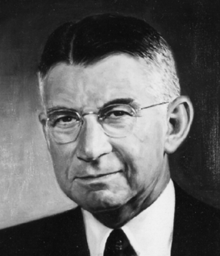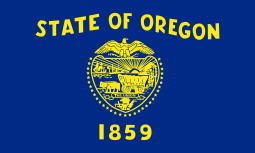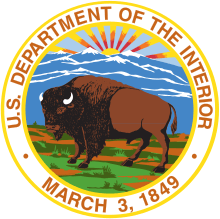Douglas McKay
James Douglas McKay (June 24, 1893 – July 22, 1959) was an American businessman and politician from the U.S. state of Oregon. He served in World War I before going into business, where he was most successful as a car dealership owner in Salem. A Republican, he served as a city councilor and mayor of Salem before election to the Oregon State Senate. McKay served four terms in the state senate, also served stateside with the rank of major in the U.S. Army during World War II, and was then elected as the twenty-fifth governor of Oregon in 1948. He left that office before the end of his term when he was selected as the thirty-fifth U.S. Secretary of the Interior during the Eisenhower administration.
Douglas McKay | |
|---|---|
 | |
| 35th United States Secretary of the Interior | |
| In office January 21, 1953 – April 15, 1956 | |
| President | Dwight D. Eisenhower |
| Preceded by | Oscar L. Chapman |
| Succeeded by | Fred A. Seaton |
| 25th Governor of Oregon | |
| In office January 10, 1949 – December 27, 1952 | |
| Preceded by | John Hall |
| Succeeded by | Paul L. Patterson |
| Personal details | |
| Born | James Douglas McKay June 24, 1893 Portland, Oregon, U.S. |
| Died | July 22, 1959 (aged 66) Salem, Oregon, U.S. |
| Political party | Republican |
| Spouse(s) | Mabel Hill
( m. 1917; |
| Children | 3 |
| Education | Oregon State University, Corvallis |
| Military service | |
| Allegiance | |
| Branch/service | |
| Battles/wars | World War I |
Early life and business career
McKay was born in Portland, Oregon, to farmer Edwin D. McKay and his wife Minnie A. Musgrove. His family's limited means required him to work while still a schoolboy.[1] After his father's death in 1911, McKay was forced to leave school before receiving a high school diploma.[2]
He was admitted to Oregon State College in Corvallis as an agriculture student at the age of twenty. McKay was elected student body president in 1916. He graduated with a Bachelor of Science degree and married Mabel Christine Hill on March 31, 1917.[3] They had one son and two daughters: Douglas, Shirley and Marylou McKay.[1]
During World War I, he served with the United States Army in Europe, where he advanced to the rank of first lieutenant.[1][4] He sustained an injury in battle to his leg, right arm, and shoulder, which earned him a Purple Heart.[4] Upon discharge, the disability prevented him from performing the strenuous activities involved with farming, so he began a business career in Portland selling insurance, and then automobiles, rising to the position of sales manager.[3] After the move to the sales manager position, the company sent him to Salem, where he was in charge of their dealership in that city.[3]
He opened Douglas McKay Chevrolet Co. in 1927,[4] and later started a Cadillac dealership as well.[3] McKay later served as president of the Oregon Automobile Dealer's Association.[5]
Early political career
McKay won election to several local political offices as a Republican, becoming mayor of Salem in 1932, and guided that city through fiscal troubles in the wake of the Great Depression.[2] Steering his city into recovery, according to a contemporary journalist quoted by biographer Herbert S. Parmet, made McKay "a firm advocate of government as well as business preserving and guarding its financial foundation."[3]
McKay was elected to the Oregon State Senate in 1934, serving four terms interrupted by service as a major in the Army during World War II.[1][5] In 1940, he was an alternate delegate to the Republican National Convention, which nominated the Willkie-McNary ticket.[6]
Governor of Oregon
He was elected governor in 1948 on a platform of fiscal conservatism and economic development.[4] As Governor, McKay took a balanced approach to state government. He was a strong advocate for resource conservation; however, he also supported cutting of old growth timber to create jobs for Oregonians. McKay actively opposed the Federal Government's plan to create a Columbia Valley Authority. He supported legislation to turn over 95 percent of the profits from the Oregon Liquor Control Commission to the state's general fund with the remaining profits going to Oregon cities based on population. He advocated expanding Oregon's highway system, supporting a successful bond issue that raised $75 million for the Oregon State Highway Department.[4] McKay won reelection as governor in 1950.[7]
Tom McCall, who would later become governor, served as McKay's executive secretary and press officer between 1949 and 1951.[8]
Secretary of the Interior
Secretary McKay and Dwight D. Eisenhower had significant ideological differences, the General being identified with the Republican moderates, and McKay with the conservative wing. Fearing that conservative Senator Robert A. Taft had little or no chance of winning the presidency in 1952, and admiring Eisenhower for his military record and leadership qualities, McKay supported Eisenhower's candidacy early in the campaign. Upon his election, Eisenhower appointed McKay as Secretary of the Interior. McKay resigned as Oregon governor on December 27, 1952.[4][5]
As the U.S. Secretary of the Interior, McKay proved himself a political asset and an effective administrator, largely because of his concern for natural resources in the western states balanced by fiscal and business acumen. As an administrator, he worked hard to balance the interests of conservationists and developers. He fostered partnerships involving the states, local public groups, private enterprise, and the Federal Government in building facilities and developing natural resources. During his tenure, McKay worked to prevent the Columbia Valley Authority and public development of the Hell's Canyon project. McKay created nine new wildlife reserves and he opposed the transfer of Wichita Mountains Wildlife Refuge property to the Army. However, he also advocated building a dam at Echo Park which would have flooded Dinosaur National Monument. In Oregon, he allowed the Alabama mining company to harvest timber; for that, his critics dubbed him, "Giveaway McKay."[3] He also supported Indian termination policy in 1954.
In Washington, McKay abolished five divisions within the Interior Department, cutting four thousand positions and reducing the budget by nearly $200 million.[2][4][9] In 1954, McKay was featured on the cover of the edition of August 23 of Time.[10]
Later years and legacy
At the urging of Eisenhower, McKay resigned March 9, 1956, effective April 15, 1956, to challenge incumbent Wayne Morse for his seat in the United States Senate.[3] He lost a fierce campaign, in no small measure because of the opposition he had engendered among Oregon conservation groups.[2] Eisenhower replaced the more conservative McKay at Interior with a Moderate Republican, Fred Andrew Seaton, a former short-term senator from Nebraska.
He died of heart attack in Salem, Oregon, at the age of sixty-six,[4] and was interred at Belcrest Memorial Park in Salem.[11]
Salem's Douglas McKay High School, built in 1979, bears his name.[12]
References
- "Douglas McKay". Salem Online History. Salem Public Library. 2006. Retrieved March 26, 2010.
- "Douglas J. McKay (1953–1956): Secretary of the Interior". American President: An Online Reference Resource. Miller Center of Public Affairs. Archived from the original on April 7, 2010. Retrieved March 26, 2010.
- Parmet, Herbert S., "(James) Douglas McKay", Dictionary of American Biography, Supplement 6: 1956–1960 (Biography Resource Center, Thomson Gale 2006 ed.), Farmington Hills, Mich.: American Council of Learned Societies, retrieved March 28, 2010
- "Governor Douglas McKay's Administration". Oregon State Archives. Oregon Secretary of State. Retrieved March 26, 2010.
- "Oregon Governor James Douglas McKay". National Governors Association. 2004. Archived from the original on February 22, 2010. Retrieved March 26, 2010.
- Kestenbaum, Lawrence (2009). "Oregon Delegation to the 1940 Republican National Convention". The Political Graveyard. Retrieved March 26, 2010.
- "Earliest Authorities in Oregon", Oregon Blue Book, Oregon State Archives, Office of the Secretary of State, Salem, Oregon, March 27, 2010.
- "Tom McCall (1913–1983)". The Oregon History Project. Oregon Historical Society. 2002. Retrieved March 26, 2010.
- "The Administration: The Old Car Peddler", Time (Vol. LXIV, No. 8), New York, New York, August 23, 1953.
- "Douglas McKay", cover image, Time, New York, New York, August 23, 1953.
- “Final Tribute Paid to Douglas McKay”, Tri-City Herald, Kennewick, Washington, July 26, 1959.
- "McKay High", Eugene Register-Guard, Eugene, Oregon, November 1, 1976.
External links
| Political offices | ||
|---|---|---|
| Preceded by John H. Hall |
Governor of Oregon 1949–1952 |
Succeeded by Paul L. Patterson |
| Preceded by Oscar Littleton Chapman |
U.S. Secretary of the Interior Served under: Dwight D. Eisenhower 1953–1956 |
Succeeded by Fred Andrew Seaton |
| Party political offices | ||
| Preceded by Earl Snell |
Republican nominee for Governor of Oregon 1948, 1950 |
Succeeded by Paul L. Patterson |
| Preceded by Wayne Morse |
Republican nominee for U.S. Senator from Oregon (Class 3) 1956 |
Succeeded by Sig Unander |


